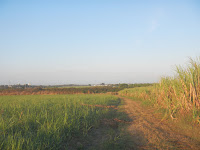Walking Cuba
Welcome to the journey! This series of posts will take you on paths that few people have explored. I'll tell you tales of walking the length and width of the most intriguing island in the Caribbean (ok. I'm biased).
I've walked the back roads and sugar cane trails (guardarayas) of Cuba for over ten years now. In some trips I followed my nose through the small towns dotting the island. In others I tried to establish a walking route along historic paths described in books and myths.
I first tried to walk Cuba, back in 2011, from east to west, coast to coast. I had the grandiose hope of linking the first seven Spanish settlements of Cuba (Las Siete Villas) into a glorious trekking experience that the true trekking enthusiast would find physically and intellectually interesting.
I only made it about 300 miles. From Baracoa to Bayamo. Baracoa, the first European settlement on the island, is on the eastern tip. It's where Columbus first set foot on the island in 1492. Bayamo, considered to be the second Spanish settlement, sits on the spine of Cuba above the Sierra Maestra mountains where the Cuban Revolution of 1959 started. It is also the town from which the first war of independence from Spain was launched in 1868. From Baracoa to Bayamo. I did go through Santiago de Cuba, the sixths of the first seven cities but poor planning was the reason I didn't go further. The Cuban people in each town cheered me on.
The second trip was more successful...sort of. It was shorter. More doable. I followed the trails recorded by anthropologists and believers tracing the history of the Caridad del Cobre (Our Lady of Charity), the patron saint of Cuba. Her statue stands high behind the altar at the cathedral of El Cobre, a mining town near Santiago de Cuba. But the statue was found floating by three fishermen, so legend goes, after a storm in the tumultuous waters of the Bay of Nipe, the largest bay in Cuba opening its arms to the ocean waters on the northern coast of the island.
After the three fishermen lifted the statue to the safety of their skiff, the statue miraculously instructed them to take her to the mining town of El Cobre. On the northwest corner of the bay lies the town of Antillas. I walked from Antillas, to the town of El Cobre, where the statue of the virgin lies, tracing the trail, the best that I could, of the Three Juanes and the statue to El Cobre. (All three fishermen were name Juan. One was a native Cuban amerindian, another was a black man and the third was a white man. Together they carried the statue 130 kilometers to El Cobre. Not much symbolism here.)
I will share my most resent walk first since that experience has developed into a project. In 2016 I traced the steps of a runaway slave, Esteban Montejo, from his birth city of Sagua La Grande on the northern coast of Cuba, to Cienfuegos, the Pearl of the Antilles on the southern coast. Esteban was the last surviving runaway slave, or cimarron, in Cuba. The anthropologist Miguel Barnett interviewed him in the early 1960s and published the most often translated book in Cuban history, (Biografia de un Cimarron) based on Esteban's life. He began the interviews when Esteban was 103 years old and published the book a few years later, in 1966. Esteban died at the age of 113 on a Saturday, February 12,1973. He is buried in Havana. A good documentary by a Spanish director based on the book is on YouTube.
I reread the book in 2015 and contacted Miguel with the idea of creating a trekking path along the areas most significant to Esteban. I did so and this is the log of that journey. It has taken me a while to put it down, given my day job, but here it is. The entire trip took thirteen days, all though trails and the web of terraplens that connect small town Cuba through the inside, and had some significant hurdles to overcome but it was done.
The plan was to create a tourist itinerary of the route. Then Covid-19 happened and all has been on hold. This year, I will move ahead with the project.
The historic trajectory covers not only the life of Esteban as a runaway slave but also traces much of Cuban history, from the development of the sugar industry, to the history of the slavery that supported the industry, to the struggle for independence form Spain and subsequent occupation by the United States. The narrative stops after the North American troops occupy Cuba in the early 1900s.
El Camino del Cimarron, (The Path of the Runaway Slave) what I have called the path and the manuscript that I hope to develop through these posts, brings the history up to date and explores a Cuba that has changed surprisingly little in over 100 years. Come with me at your pace. Should be interesting.


No comments:
Post a Comment